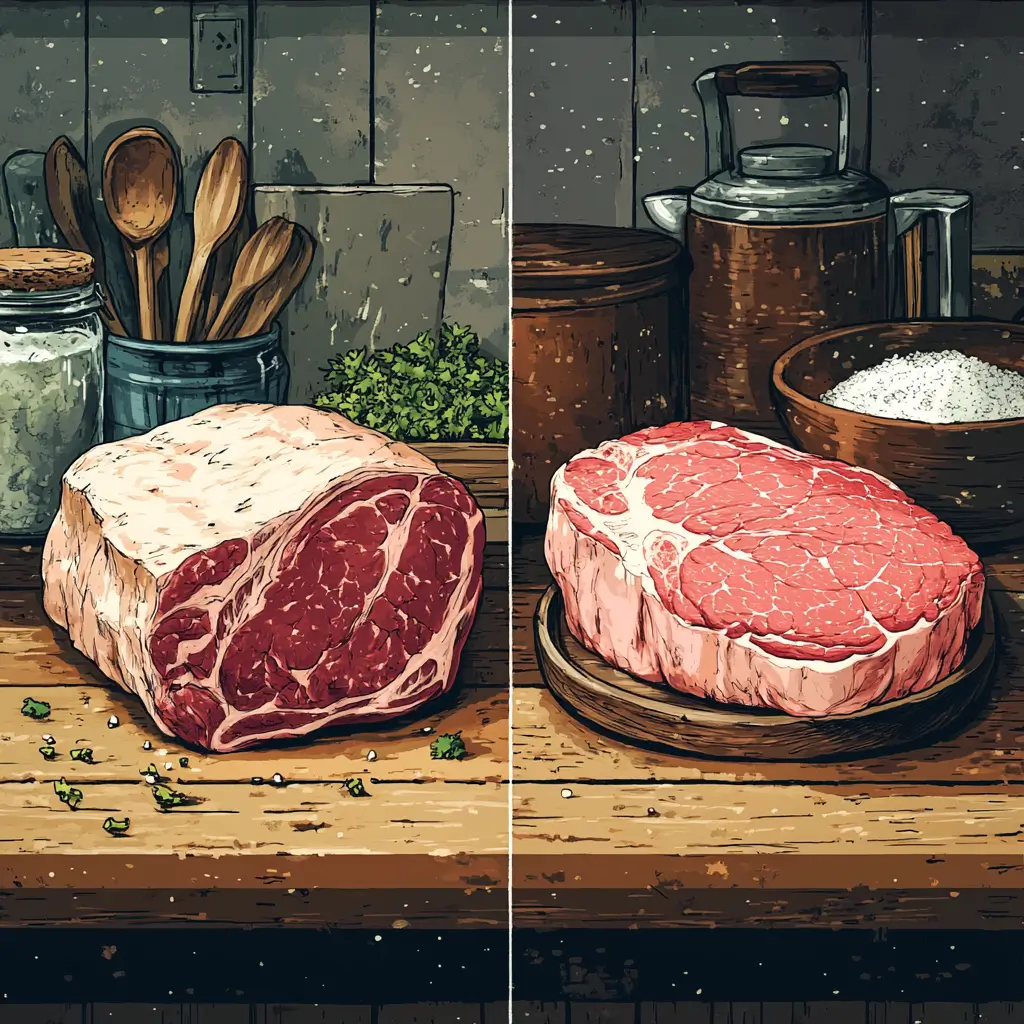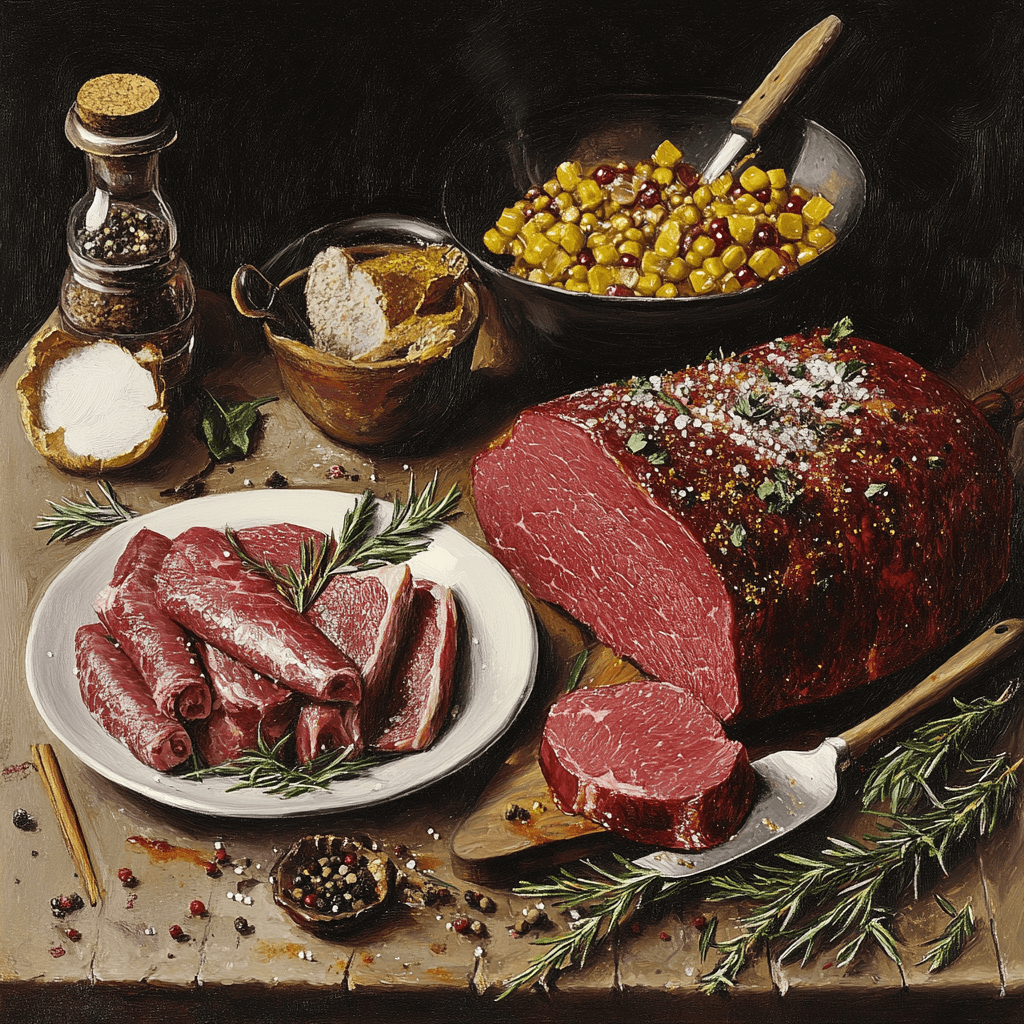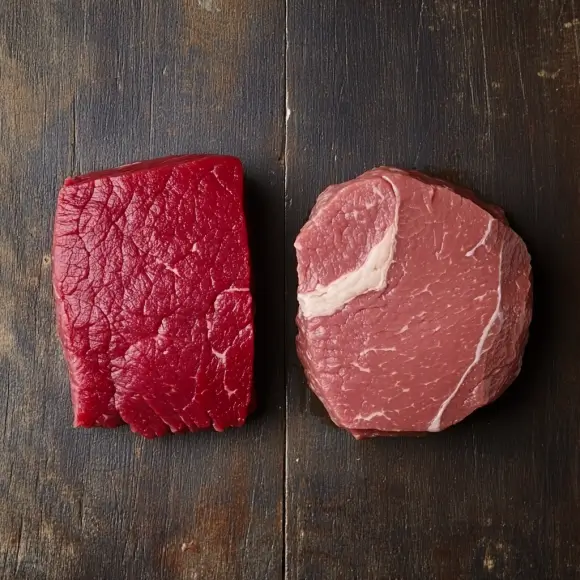- What is Silverside?
- What is Corned Beef?
- Is Silverside Used to Make Corned Beef?
- Cooking Techniques for Silverside and Corned Beef
- Nutritional Comparison: Silverside vs Corned Beef
- Which One Should You Choose: Silverside or Corned Beef?
- Common Misconceptions About Silverside and Corned Beef
- Silverside and Corned Beef in Different Cultures
- Can Silverside Be Used as a Substitute for Corned Beef?
- How to Store Silverside and Corned Beef Properly
- Health Benefits of Silverside and Corned Beef
- Is Silverside the Same as Corned Beef?
- Conclusion: Final Thoughts on Silverside vs Corned Beef
Table of Contents
What is Silverside?
Is silverside the same as corned beef? While they are related, these terms describe two distinct things. Silverside refers to a lean cut of beef from the hindquarter, commonly used in various recipes. Corned beef, on the other hand, is silverside or brisket that has been cured in brine, resulting in its salty, tangy flavor and tender texture. Understanding the key differences between silverside and corned beef can help you make the best choice for your dish.
Key Features of Silverside:
- Lean meat with minimal fat marbling.
- Best suited for slow-cooking methods to tenderize the meat.
- Popular in dishes like pot roasts, stews, and braised beef recipes.
Silverside is a versatile option for cooking, but its texture requires careful preparation to guarantee it doesn’t become tough.
In some regions, silverside is known by different names; for example, in the United States, it is referred to as the “bottom round”.
What is Corned Beef?
Corned beef is a type of cured meat that people often make from brisket or silverside. This connection frequently raises the question, “Is silverside the same as corned beef?” The answer is no. Silverside starts as raw, unseasoned meat. To cure beef, cooks soak it in a brine made of salt and spices. This curing process creates the tangy, salty flavor and tender texture that make corned beef different from fresh silverside.
Features of Corned Beef:
- Salt-cured with added spices for flavor.
- Often boiled or simmered to develop its unique taste.
- Used in dishes such as corned beef hash, sandwiches, and as a main dish in traditional Irish meals.
Its distinctive tangy and salty flavor sets it apart from regular beef cuts. Corned beef also has a softer texture, making it an appealing option for many recipes.
Key Differences Between Silverside and Corned Beef

People often ask, “Is silverside the same as corned beef?” because silverside is often used to make corned beef. However, the two are clearly different.
Comparison of Silverside and Corned Beef:
- Preparation:
- Silverside: A raw cut of beef, often prepared fresh.
- Corned Beef: Cured and seasoned in brine, requiring additional processing.
- Flavor:
- Silverside: Mild, natural beef flavor.
- Corned Beef: Salty, spiced flavor due to the curing process.
- Texture:
- Silverside: Lean and firm, which requires slow cooking for tenderness.
- Corned Beef: Softer, due to the brining and cooking process.
- Uses:
- Silverside: Ideal for pot roasts or braising.
- Corned Beef: Versatile for sandwiches, hashes, and standalone meals.
For more insights into the differences between these cuts, check out the guide on “Silverside vs Brisket: Key Differences, Cooking Tips, and Nutrition”.
Is Silverside Used to Make Corned Beef?
Yes, silverside is often used to make corned beef. Its lean and firm texture makes it a popular choice. However, not all corned beef comes from silverside; brisket is another common option.
Why Use Silverside for Corned Beef?
- Lean Cut: Silverside has less fat, making it perfect for curing and slow cooking.
- Flavor Absorption: Its dense structure soaks up the flavors of the brine and spices well.
- Texture: When cured and cooked, silverside becomes tender while keeping its shape.
It’s important to remember that silverside is not the same as corned beef. The curing process is what changes silverside into the flavorful corned beef we know.
Cooking Techniques for Silverside and Corned Beef
Cooking techniques vary greatly depending on whether you are working with silverside or corned beef. Each requires specific methods to bring out its best qualities.
Cooking Silverside:
- Slow-Cooking: Ideal for achieving tender results; braising or pot roasting works well.
- Stewing: Silverside can be cubed and slow-cooked in liquid for hearty stews.
- Roasting: Best when cooked at low temperatures for an extended period to retain moisture.
Cooking Corned Beef:
- Simmering: A common method that keeps the meat moist while enhancing flavor.
- Pressure Cooking: Speeds up the cooking process while maintaining tenderness.
- Oven Braising: Adds depth of flavor with additional spices and liquids.
Nutritional Comparison: Silverside vs Corned Beef
When deciding between silverside and corned beef, nutritional value is a significant consideration.
Nutritional Profile of Silverside:
- Calories: Lower in calories due to its lean nature.
- Protein: High protein content, making it a good choice for muscle building.
- Fat: Minimal fat, ideal for those on low-fat diets.
Nutritional Profile of Corned Beef:
- Calories: Higher due to the curing process and added ingredients.
- Sodium: Contains significantly more salt because of the brining.
- Protein: Still a good source of protein, though slightly less than fresh silverside.
If health is a priority, silverside may be the better choice. However, corned beef offers unique flavor that makes it a satisfying indulgence.Taste and Texture Comparison
Taste and texture significantly influence the choice between silverside and corned beef, depending on your culinary needs.
Taste:
In contrast, corned beef delivers a bold, tangy, and salty taste. Its depth of flavor results from the curing process, which sets it apart from silverside.
The flavor of silverside is mild and unseasoned, offering great versatility for a variety of dishes.
Texture:
- Silverside: Firm and structured, requiring careful cooking to avoid toughness.
- Corned Beef: Tender and soft, making it easier to chew and enjoy in various dishes.
For those seeking a natural, unadulterated beef taste, silverside is preferable. Conversely, corned beef’s savory profile is ideal for robust recipes.
You can find creative ways to cook silverside with step-by-step recipes at “Silverside Beef Recipe Tips”.
Which One Should You Choose: Silverside or Corned Beef?
Choosing between silverside and corned beef depends on what you need for your cooking and your personal taste.
When to Choose Silverside:
- You want a leaner, healthier meat option.
- You like to season and flavor the meat yourself.
- You’re preparing dishes like pot roast or stews.
When to Choose Corned Beef:
- You need a ready-to-eat, flavorful choice.
- You’re making sandwiches, hashes, or classic dishes like corned beef and cabbage.
- You prefer meat with a softer, more tender texture.
Common Misconceptions About Silverside and Corned Beef
Many people assume silverside and corned beef are identical due to their similar appearance and preparation methods. However, the two are not interchangeable. One common misconception is that they refer to the same cut of meat. While silverside is a specific cut from the hindquarter of the cow, corned beef is typically cured meat, often made from brisket or other cuts, including silverside.
Another misunderstanding is that all corned beef tastes the same. This belief overlooks the variations in seasoning and curing methods used across different regions. Similarly, people often think silverside must always be cured, but it can be cooked fresh as a roast or boiled for a traditional meal.
Understanding these distinctions is crucial because they impact cooking techniques, flavor, and texture. These factors determine whether you’ll achieve the desired taste and consistency in your dish.
Silverside and Corned Beef in Different Cultures
Silverside and corned beef play significant roles in cuisines around the world. In Ireland, corned beef is synonymous with St. Patrick’s Day celebrations, often served alongside cabbage and potatoes. The Irish preparation involves curing the meat with salt and spices, creating a tender, flavorful dish.
In contrast, British and Australian cuisines often highlight silverside in classic roasts. In these cultures, silverside is frequently served as part of a hearty Sunday dinner, accompanied by roasted vegetables and Yorkshire pudding. While it may be cured into corned beef, it’s also appreciated fresh.
Jewish delis in the United States serve corned beef as a key ingredient in Reuben sandwiches, while Caribbean communities use it in dishes like buljol. Silverside, however, rarely appears outside of curing and roasting contexts, showing how cultural preferences influence how these meats are consumed.
Despite their differences, the question “Is silverside the same as corned beef?” often arises because of their overlapping uses.
Can Silverside Be Used as a Substitute for Corned Beef?
The answer to whether silverside can replace corned beef depends on the recipe. Since silverside is often used to make corned beef, they share some similarities. However, fresh silverside lacks the cured flavor characteristic of corned beef.
When cooking dishes like hash or sandwiches where the distinctive cured taste of corned beef is essential, using fresh silverside may not deliver the expected flavor. You can, however, cure silverside at home to mimic corned beef by soaking it in a brine of salt, sugar, and spices for several days.
If you’re making a stew or roast, fresh silverside works well, even if the recipe originally calls for corned beef. The texture of silverside may be slightly firmer, but the difference is often subtle when cooked correctly.
Ultimately, while the two are related, understanding the nuances behind “Is silverside the same as corned beef?” helps in making substitutions successfully.
How to Store Silverside and Corned Beef Properly
Proper storage guarantees the freshness and quality of both silverside and corned beef. For fresh silverside, refrigerate it at a temperature below 40°F (4°C) and consume it within three to five days. If you don’t plan to cook it within this timeframe, freezing is a better option. Wrap the silverside tightly in freezer-safe packaging to prevent freezer burn.
Canned corned beef, on the other hand, has a much longer shelf life. Store unopened cans in a cool, dry place, and check the expiration date regularly. Once opened, transfer any leftovers to an airtight container and refrigerate them, consuming within three to four days.
If you’ve prepared corned beef from silverside, store it similarly to fresh meat. Always remember that cooked or cured meat should not sit at room temperature for more than two hours to prevent bacterial growth.
These storage tips apply whether you’re asking, “Is silverside the same as corned beef?” or trying to preserve their individual flavors.
Health Benefits of Silverside and Corned Beef
Silverside and corned beef provide various health benefits, though their nutritional profiles differ. Silverside offers a lean source of protein and contains less fat than many other cuts. It delivers essential nutrients like iron, zinc, and B vitamins, which help the body produce energy and maintain a healthy immune system.
Corned beef, while still a good protein source, tends to be higher in sodium due to the curing process. This high sodium content may pose health risks for individuals managing hypertension or heart conditions. However, it still provides important minerals like iron and vitamin B12.
Moderation is key when incorporating either into your diet. Opt for fresh silverside when you want a leaner option and use corned beef sparingly to enjoy its rich flavor without overindulging in sodium. The discussion around “Is silverside the same as corned beef?” highlights these differences in health impacts.
Is Silverside the Same as Corned Beef?
The short answer to “Is silverside the same as corned beef?” is no. Silverside refers to a specific cut of beef from the hindquarter, and corned beef describes meat cured in a salt solution. Producers often use silverside to make corned beef, but the two remain fundamentally different.
When silverside is cured, it develops the salty, tangy flavor associated with corned beef. However, fresh silverside lacks this distinctive taste. This distinction matters when selecting ingredients for recipes. For example, you wouldn’t achieve the same results using fresh silverside in a recipe designed for pre-cooked corned beef.
Understanding these differences helps dispel confusion and guarantees your dishes turn out as expected. While they share some common ground, their unique characteristics make them suitable for different culinary uses.
FAQs:
Is silverside different to corned beef?
Yes, silverside differs from corned beef. Silverside refers to a specific cut of beef from the cow’s hindquarter, valued for its lean texture. Corned beef, however, describes beef—often silverside or brisket—that undergoes curing in a brine with salt, spices, and preservatives. While people can use silverside to make corned beef, they are not the same. The curing process transforms silverside into corned beef, creating its distinct salty and tangy flavor, which fresh silverside does not possess.
What is the American version of silverside?
In the United States, people typically refer to silverside as bottom round. This cut comes from the cow’s hindquarter and has a similar lean texture. Cooks often use bottom round for roasts, stews, and deli-style sliced meats. In American cuisine, brisket is more commonly used than bottom round for making corned beef, reflecting a preference for its marbling and texture.
What do Australians call corned beef?
Australians often call corned beef “corned silverside” when it is made from the silverside cut. This term highlights the common use of silverside in Australia for curing into corned beef. Australians may also refer to the canned version simply as corned beef. For fresh cured meat, “corned silverside” is the preferred term, emphasizing the cut used in preparation
What is a substitute for beef silverside?
If you’re looking for a substitute for beef silverside, the following cuts work well depending on your recipe:
Eye of Round: A lean and firm cut that can substitute for silverside in many dishes, though it may be slightly less tender.
Brisket: Ideal for curing into corned beef or slow-cooking for tender results.
Topside: Another lean cut from the hindquarter, similar to silverside in texture and flavor.
Rump Roast: A slightly more marbled cut that performs well in roasting and stewing.
Conclusion: Final Thoughts on Silverside vs Corned Beef

In conclusion, while silverside and corned beef are closely related, they are not identical. Corned beef, on the other hand, undergoes a curing process that significantly alters its flavor and texture.
By addressing the question, “Is silverside the same as corned beef?”, we’ve tried their unique characteristics, cultural significance, and culinary applications. Whether you’re seeking a lean protein source like fresh silverside or craving the savory taste of corned beef, knowing the differences guarantees you choose the right option for your meal.
Ultimately, both have their place in the kitchen, and understanding when and how to use each can improve your cooking to new heights.
For deeper insights into the cut and its uses, check the article on “What is Silverside Called in the USA?”.


3 thoughts on “Silverside vs Corned Beef: Key Differences, Uses, and Benefits”